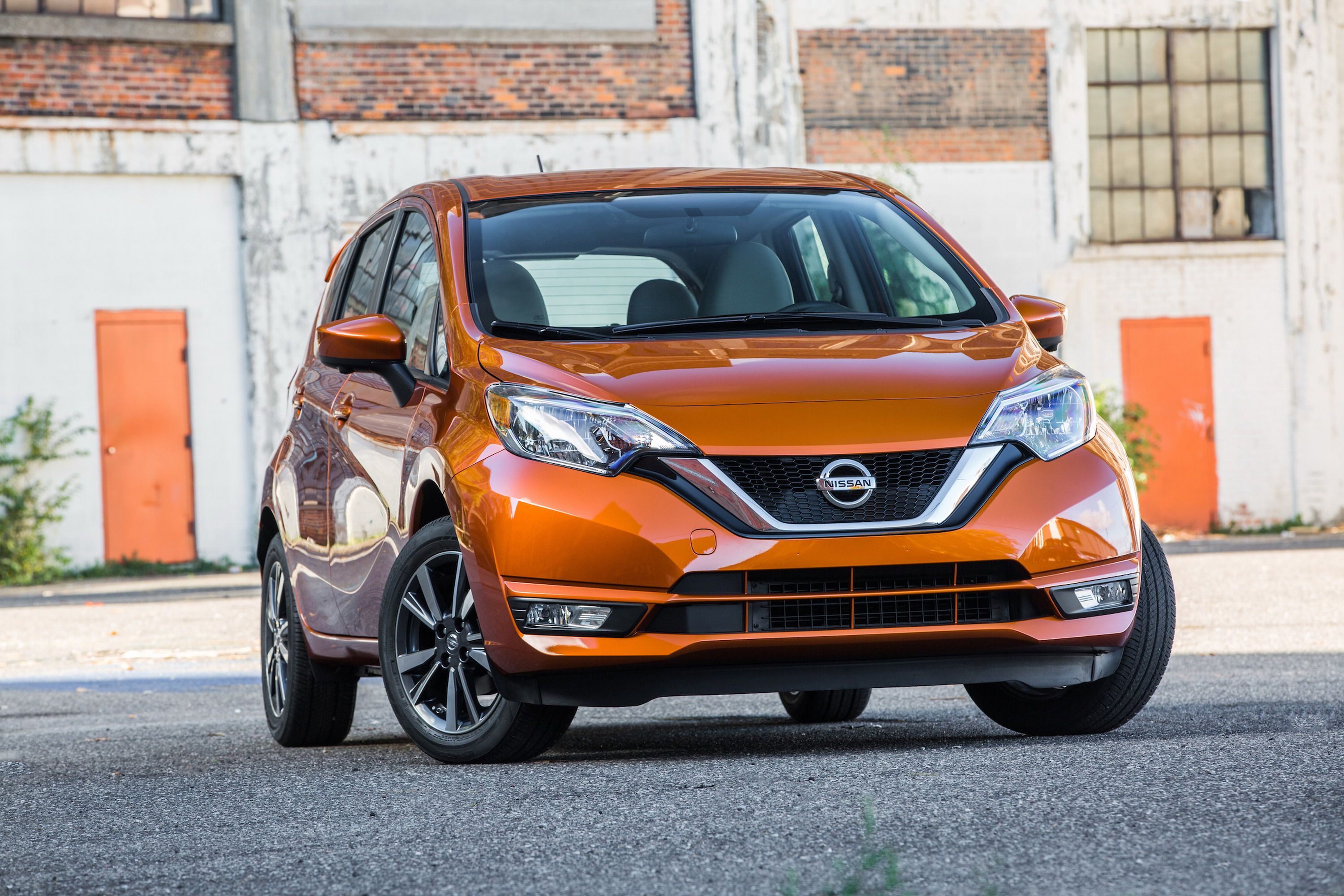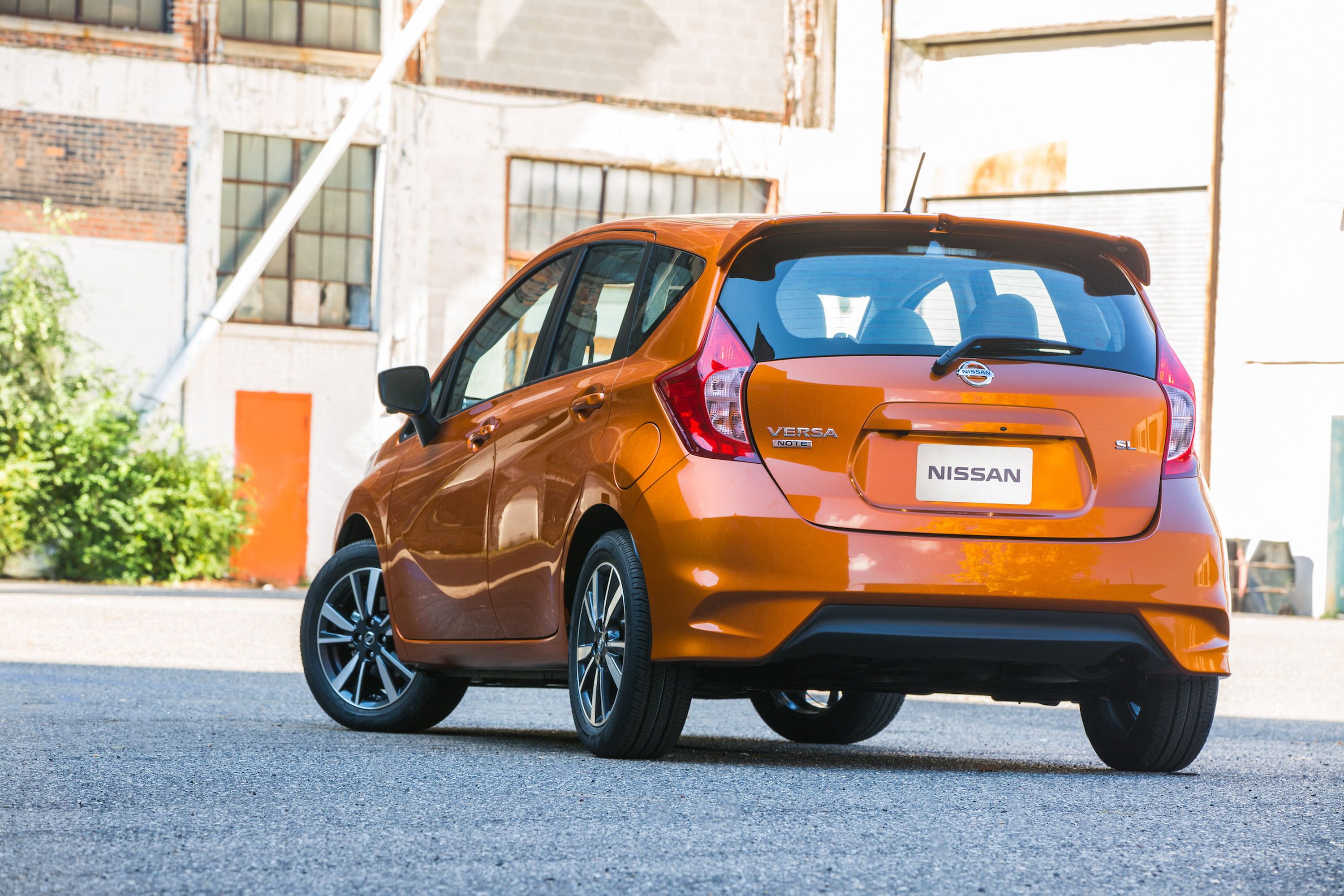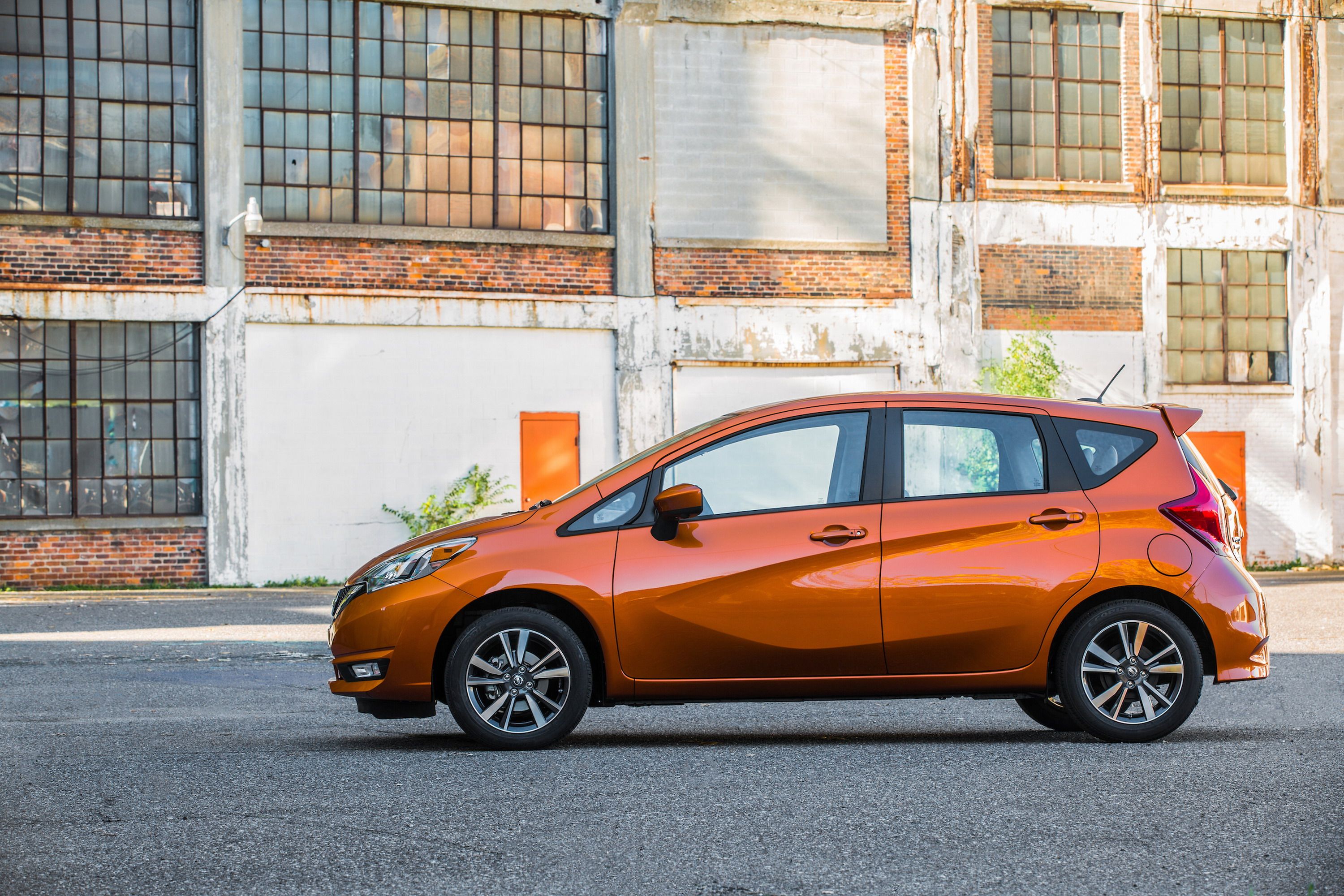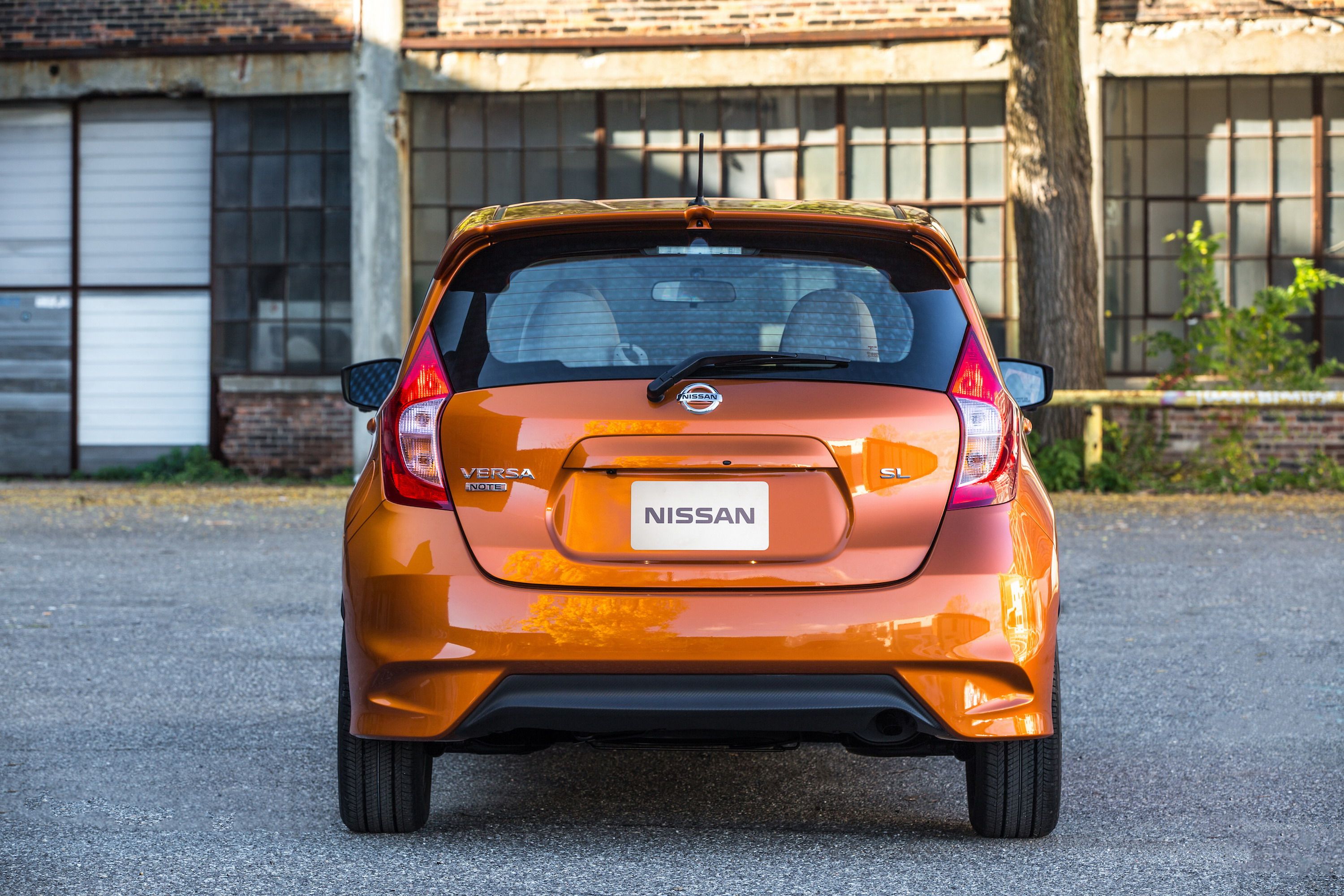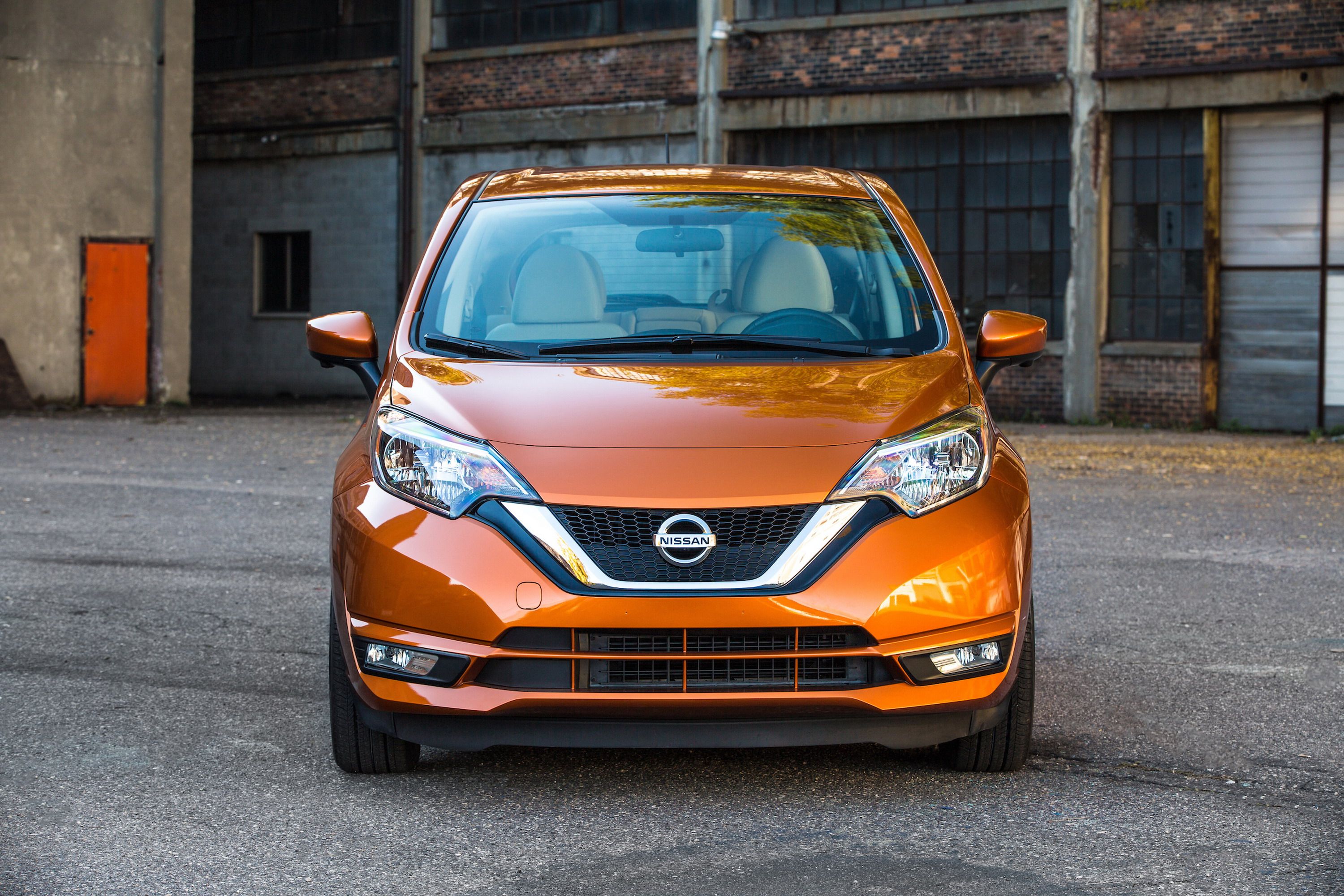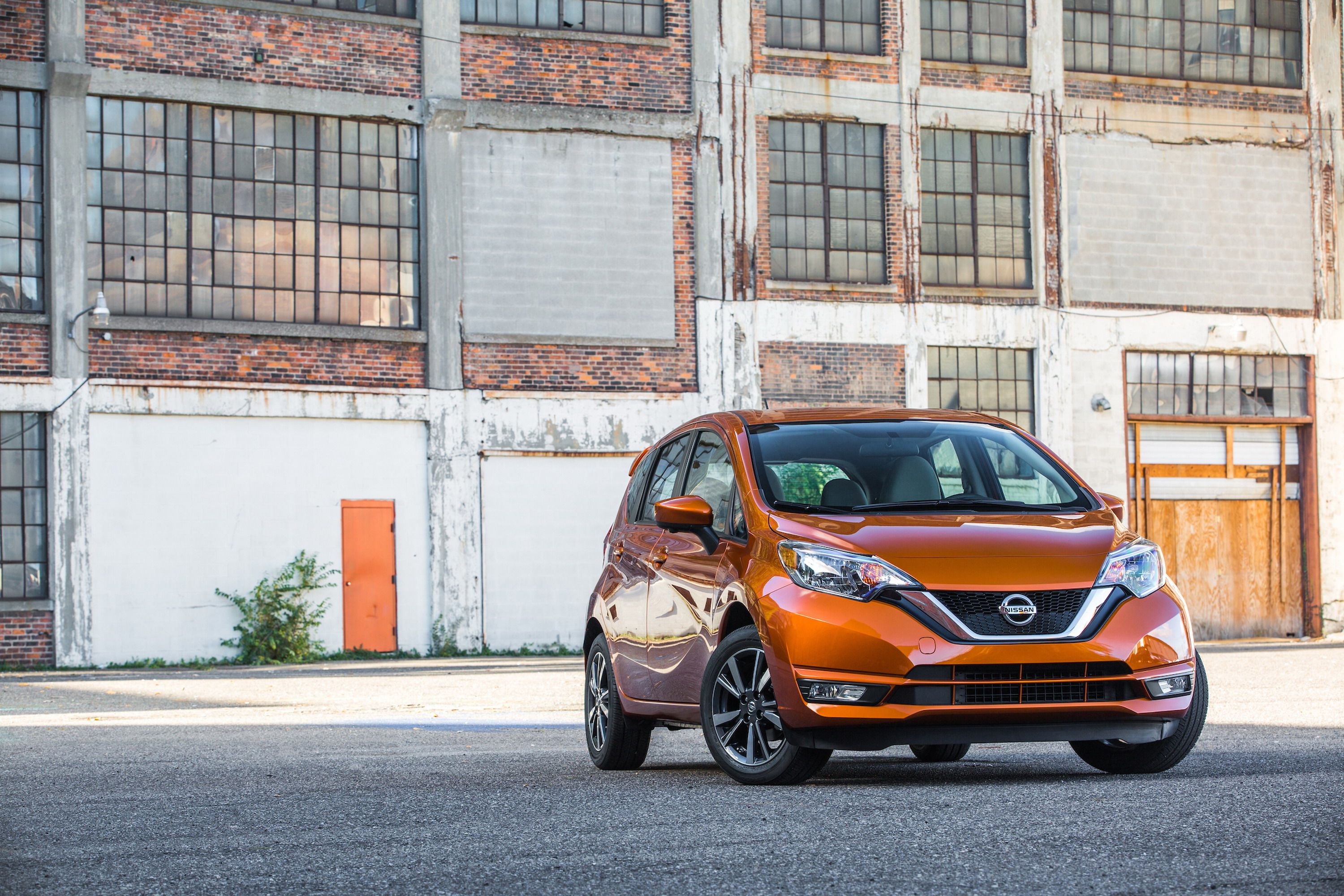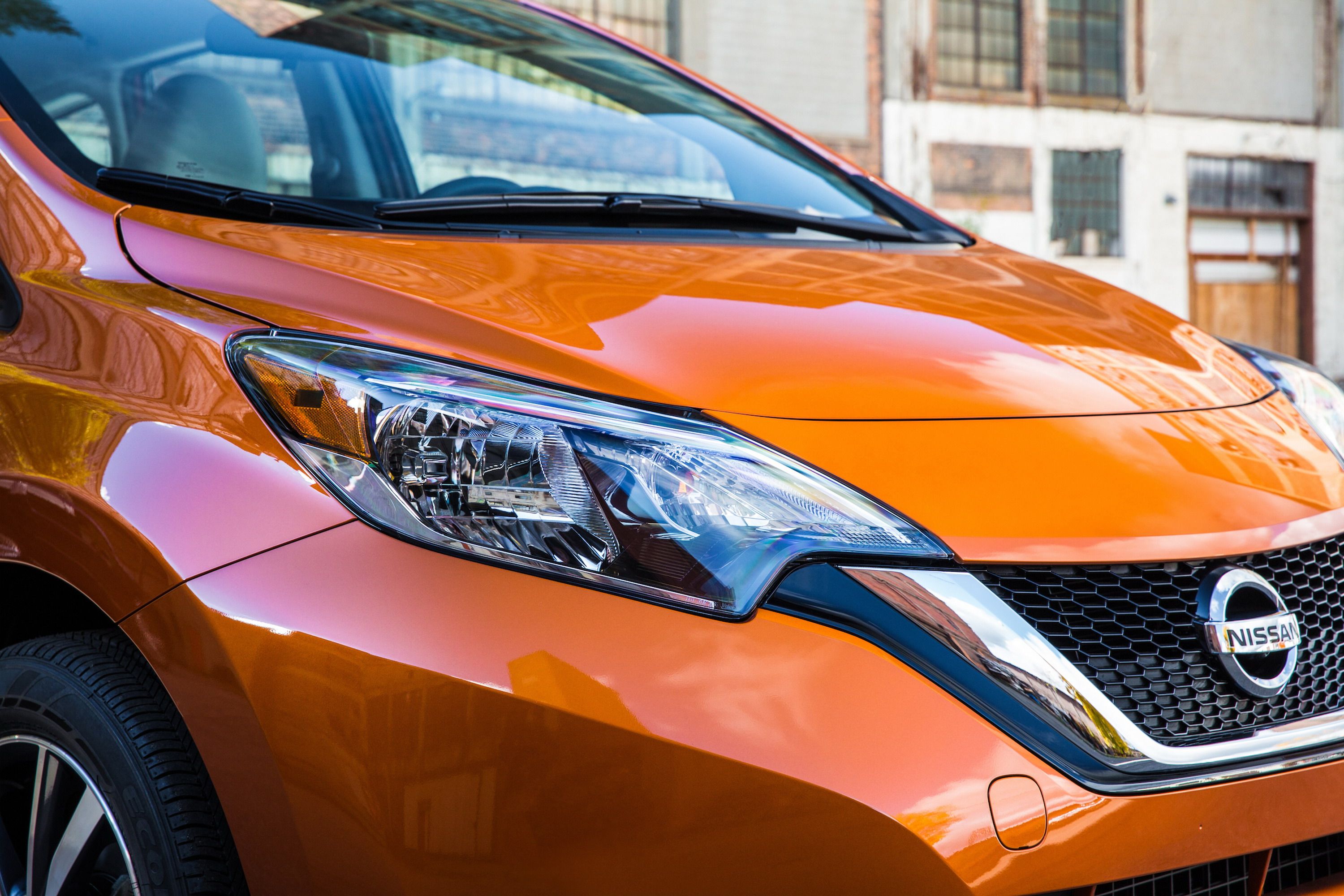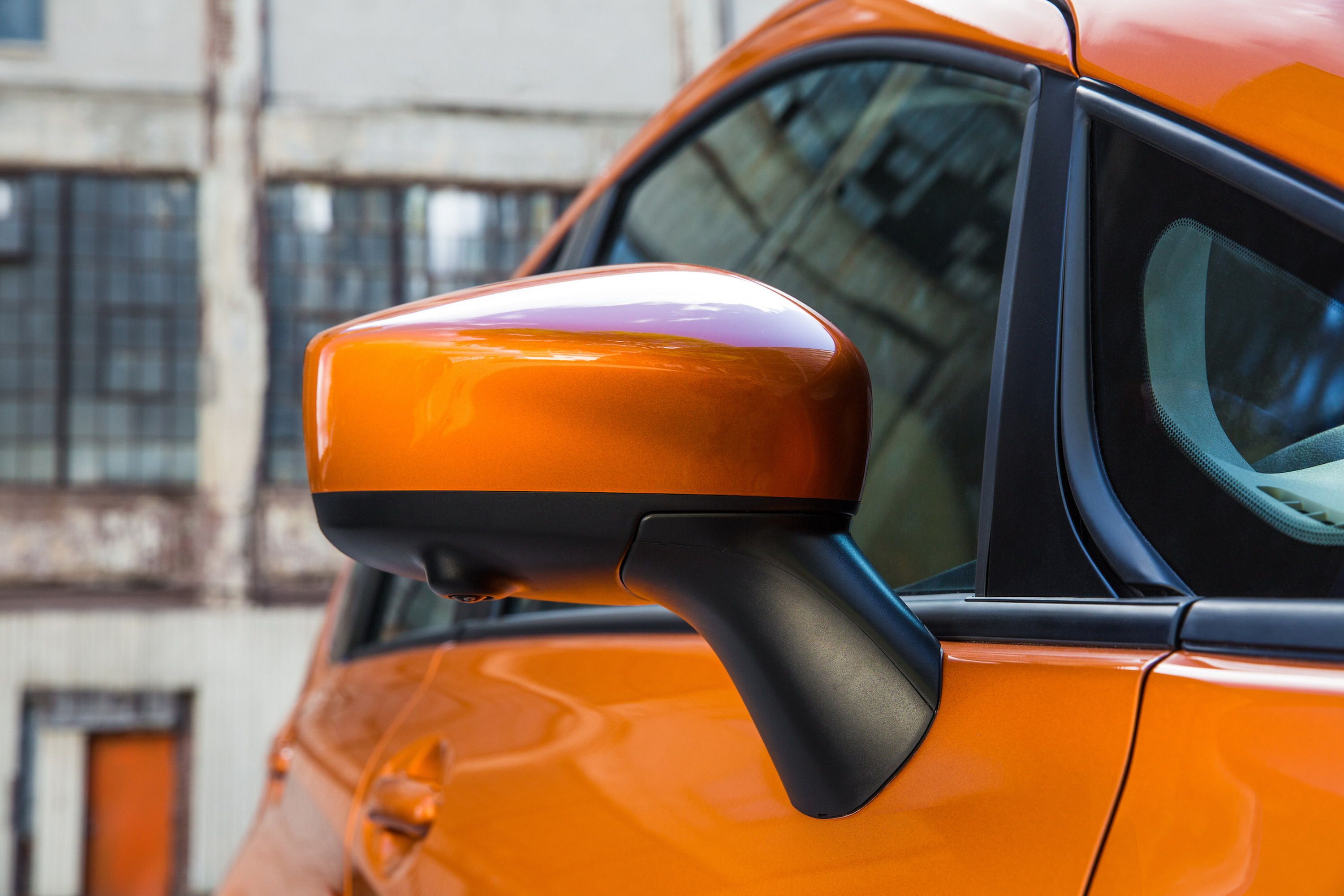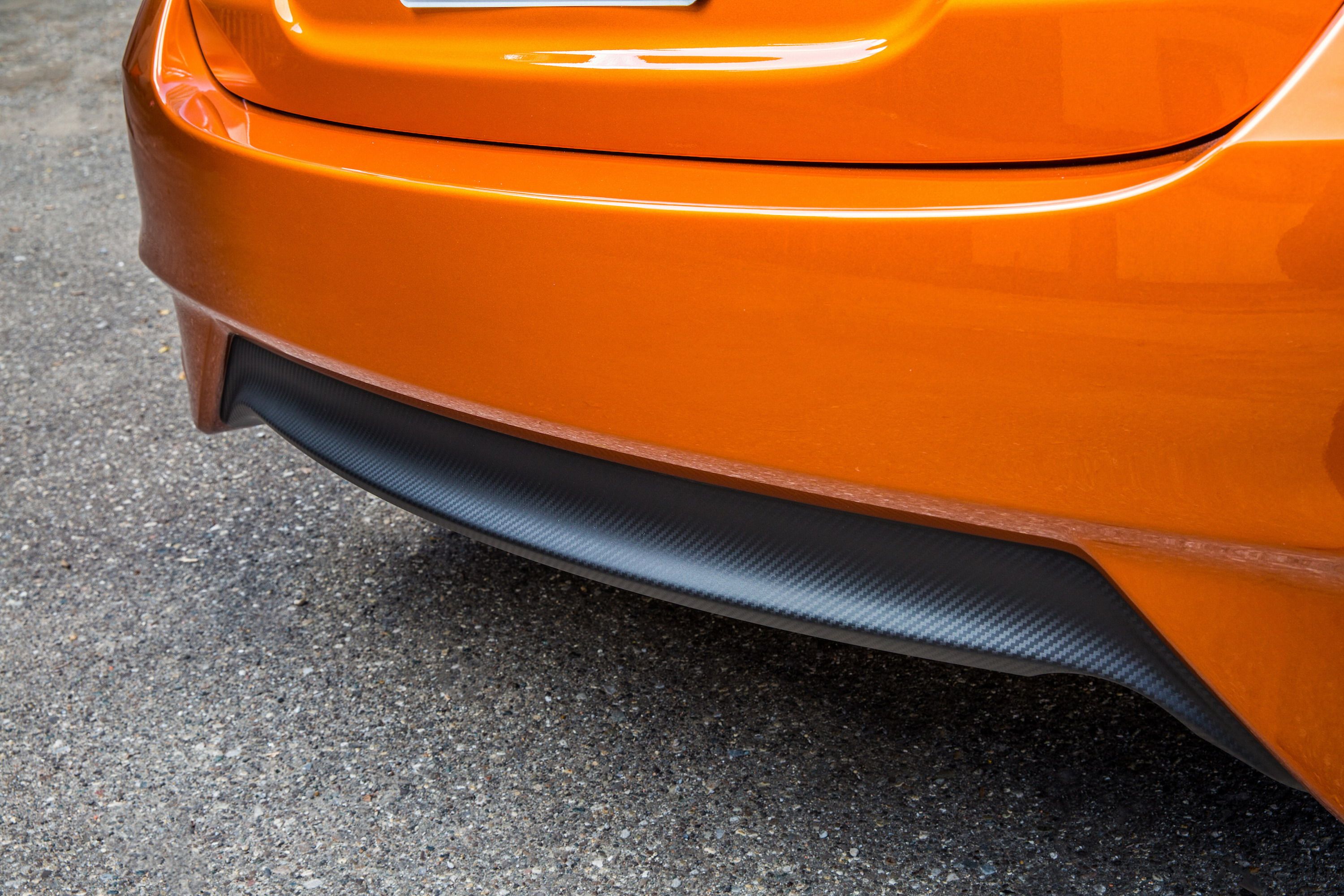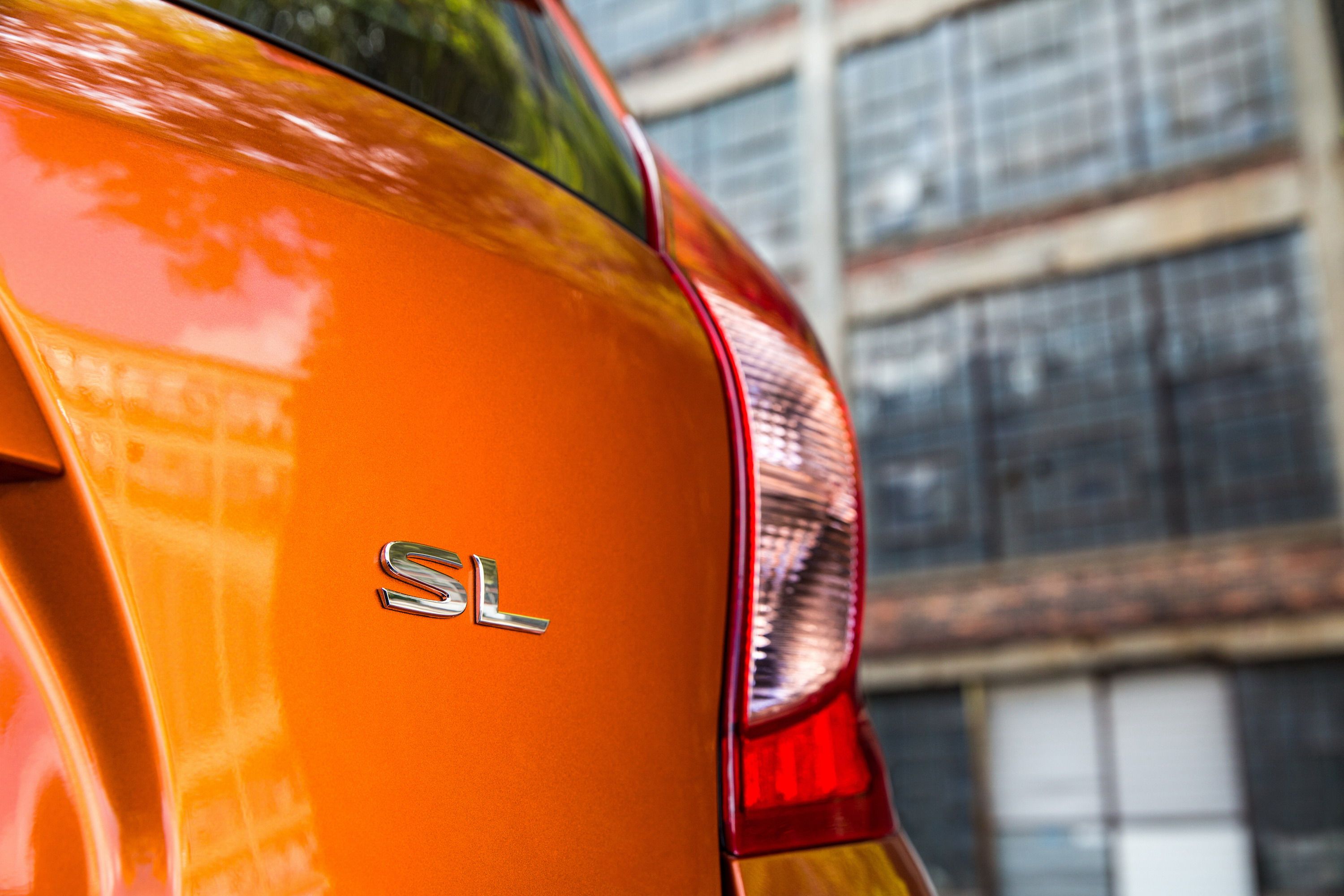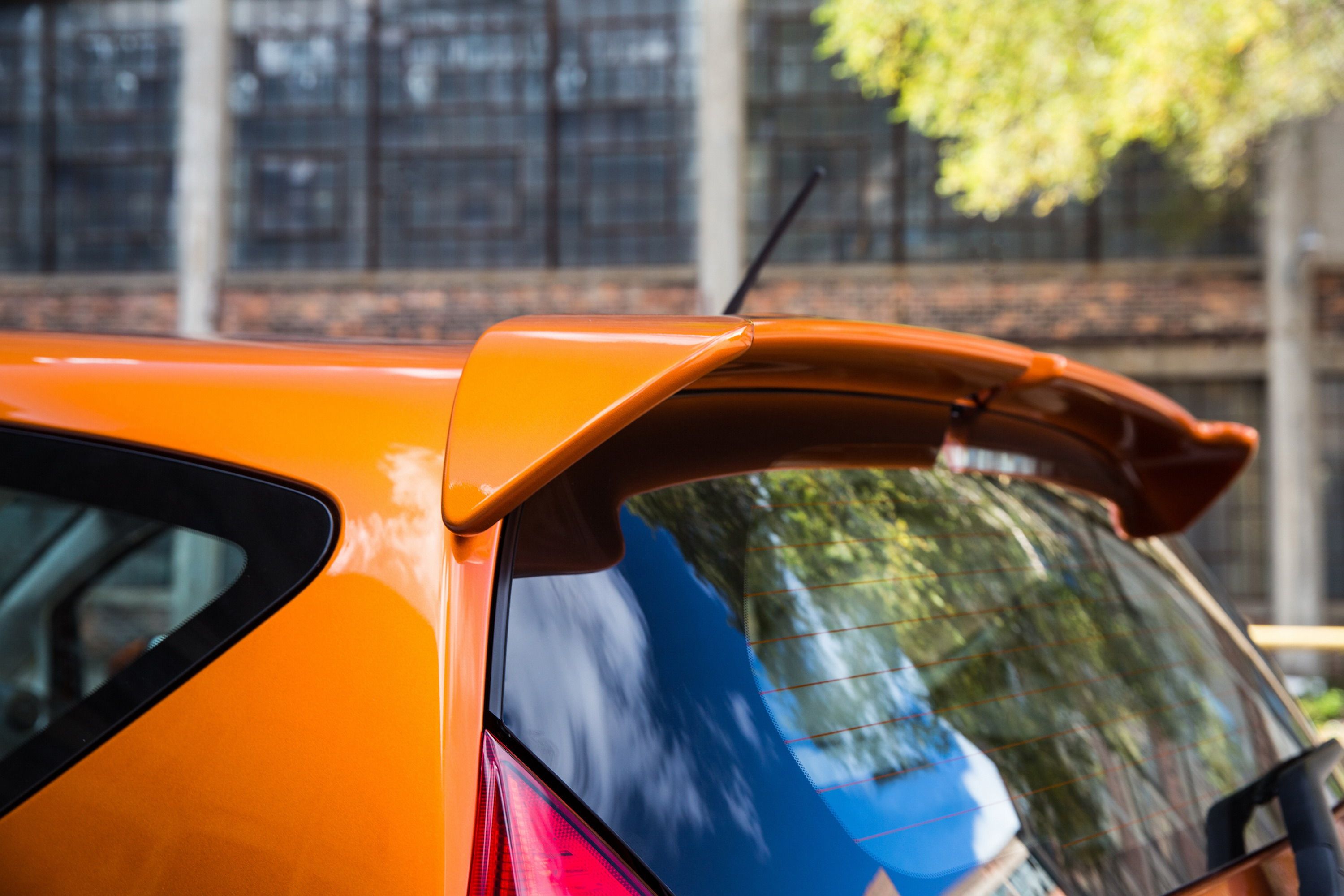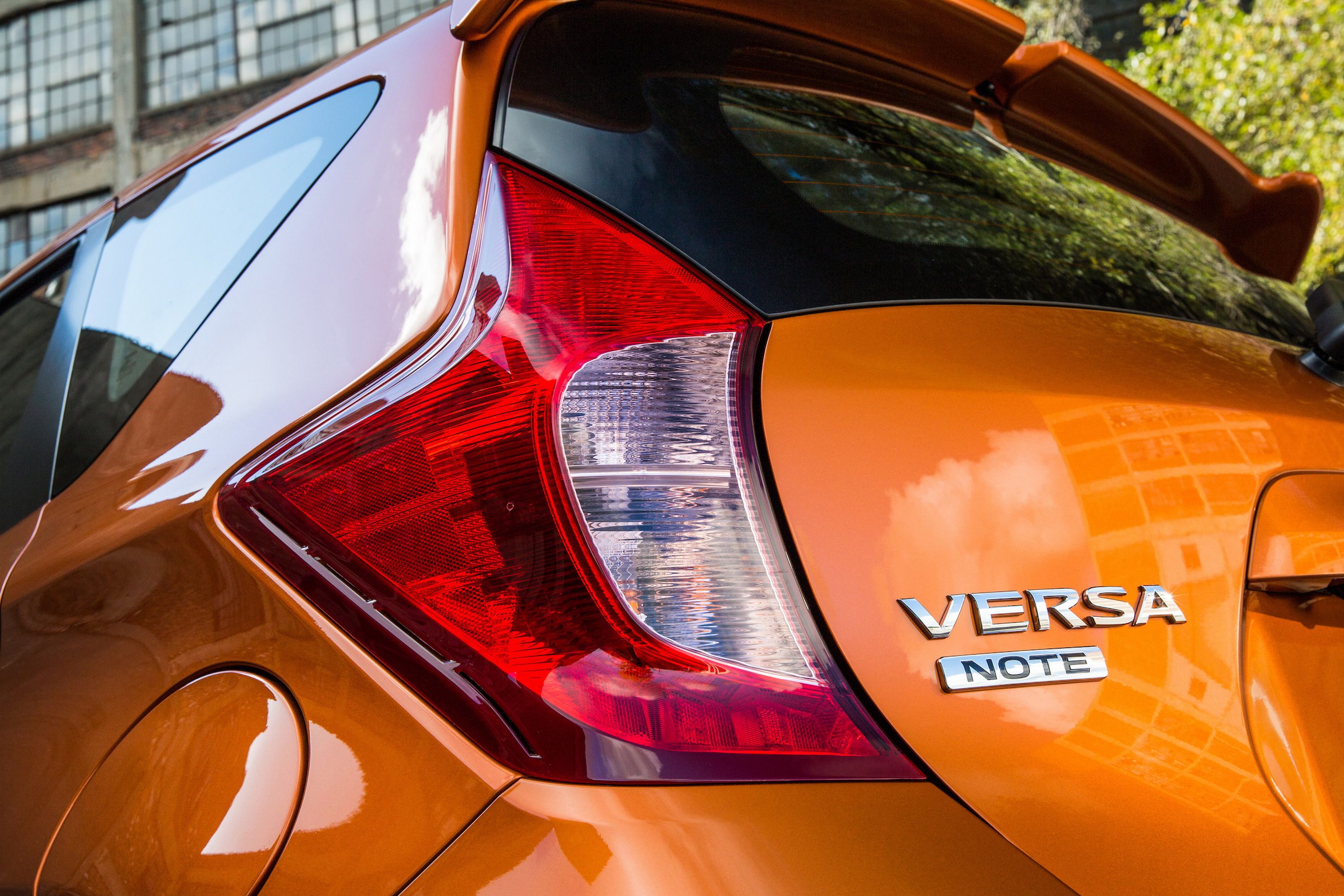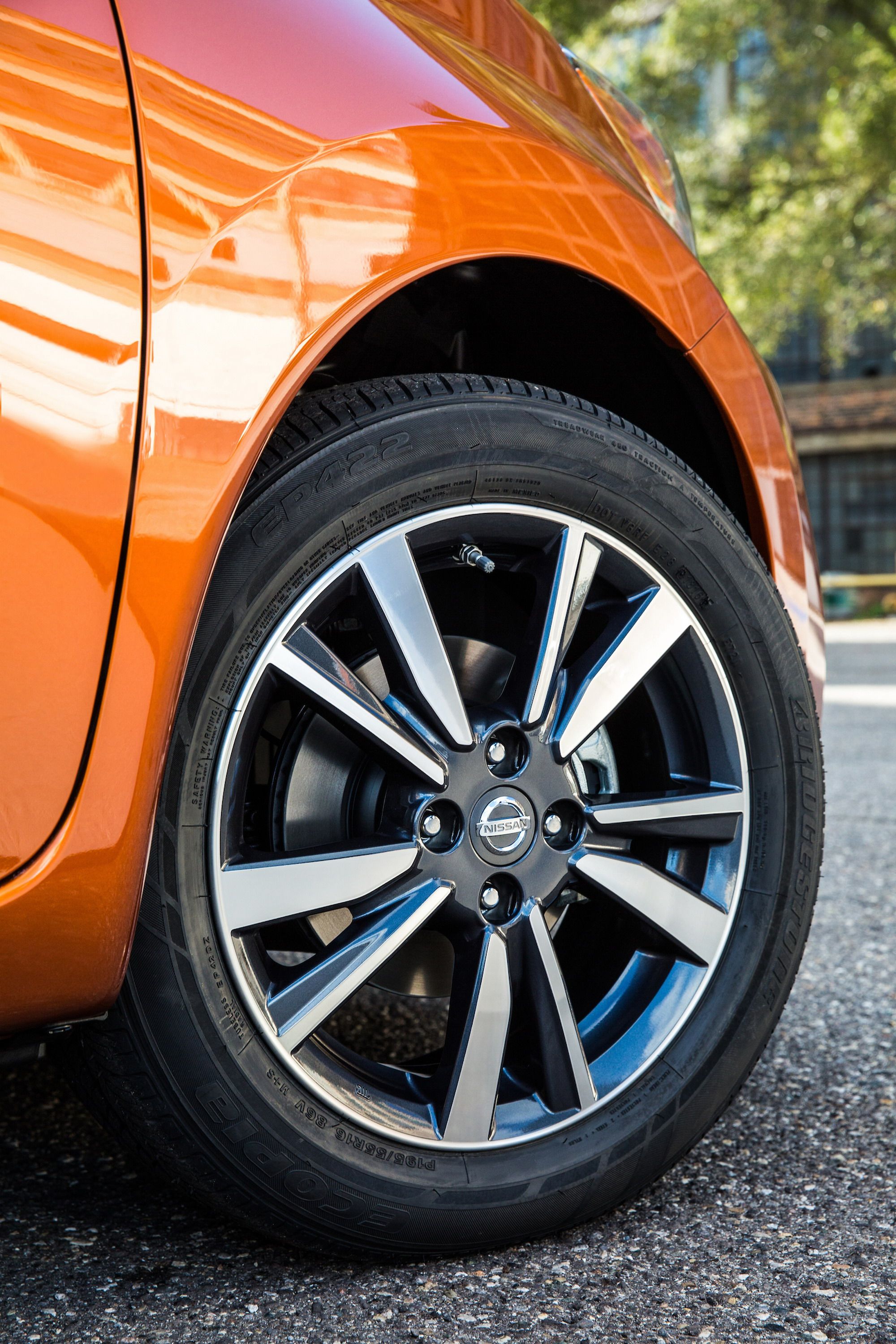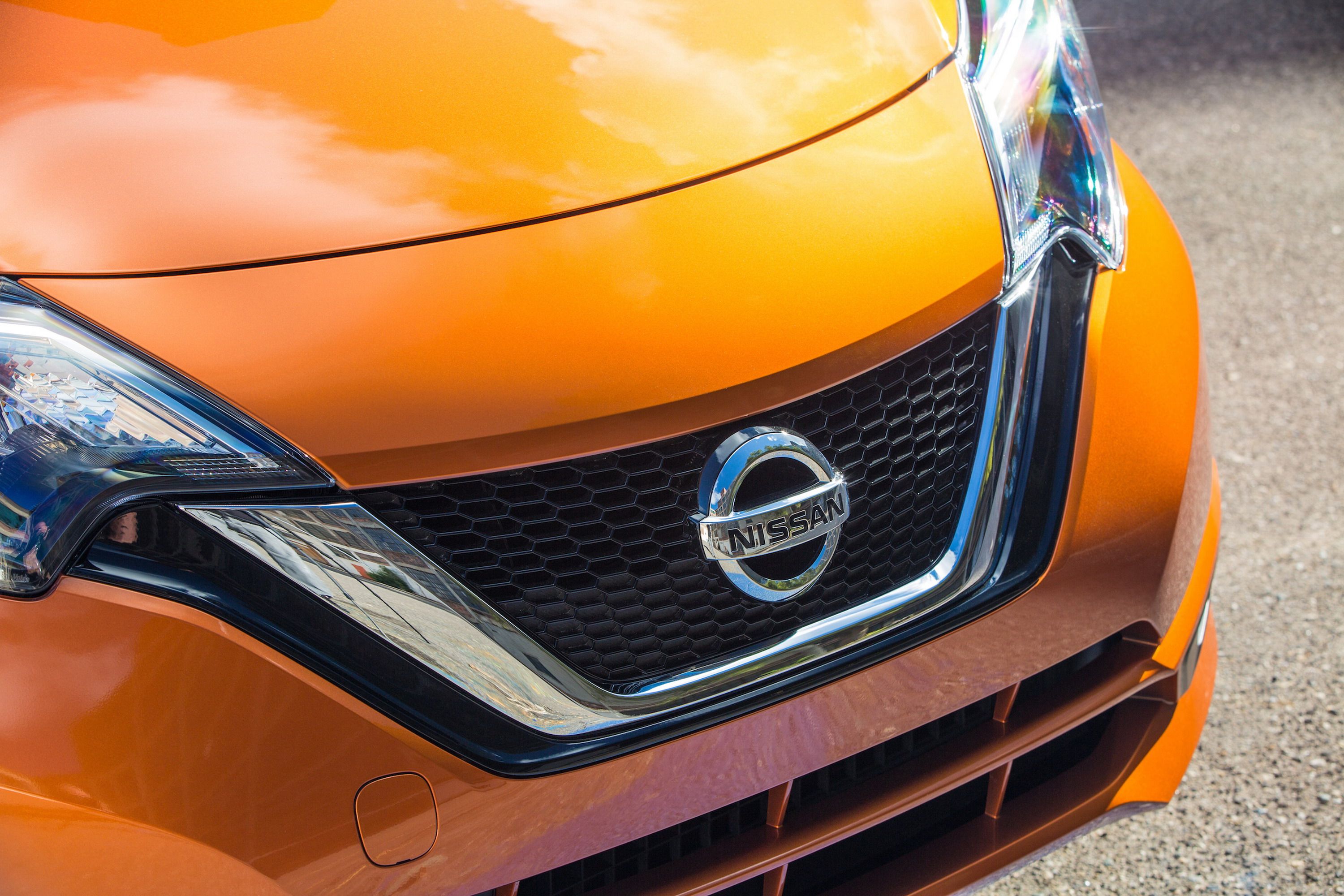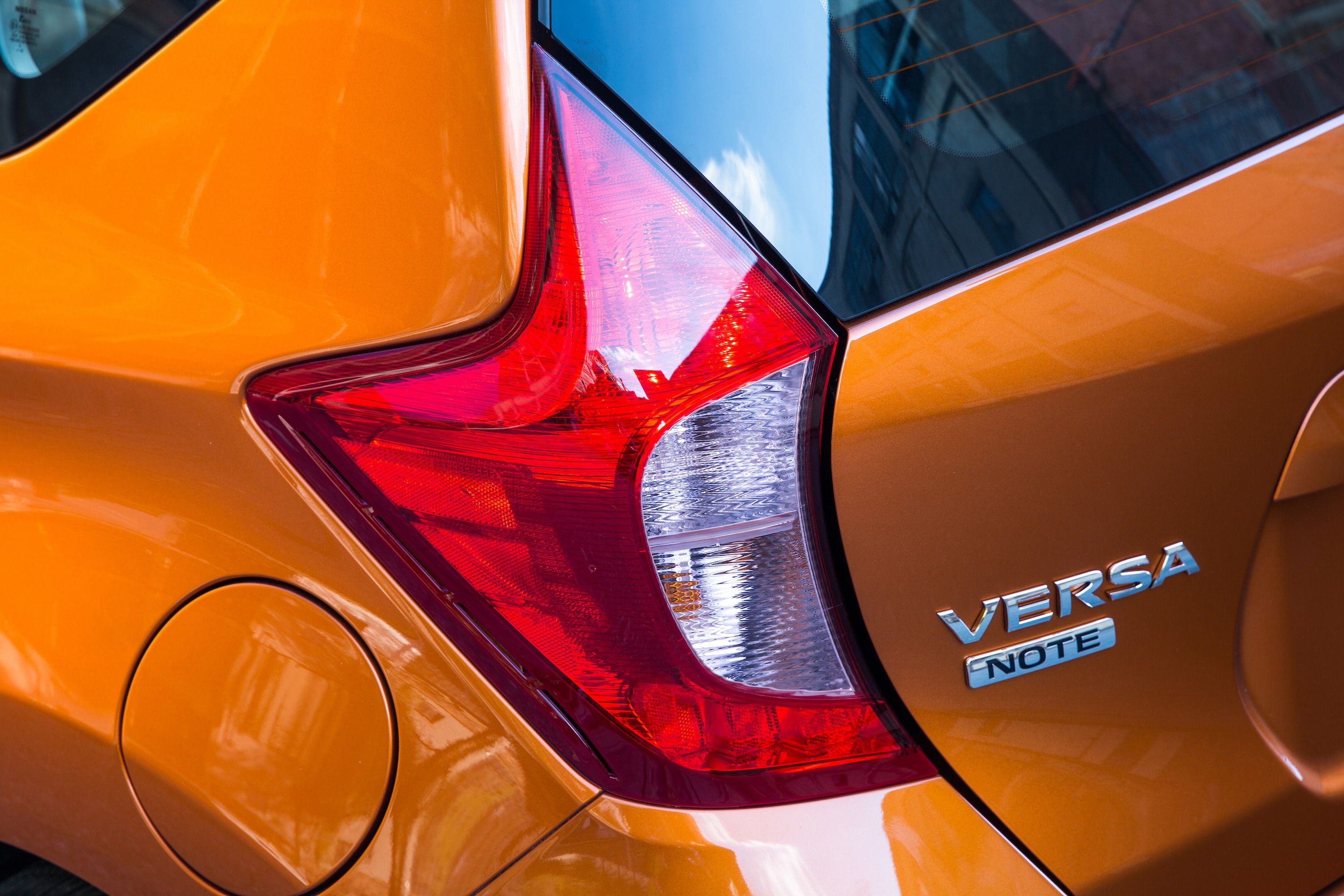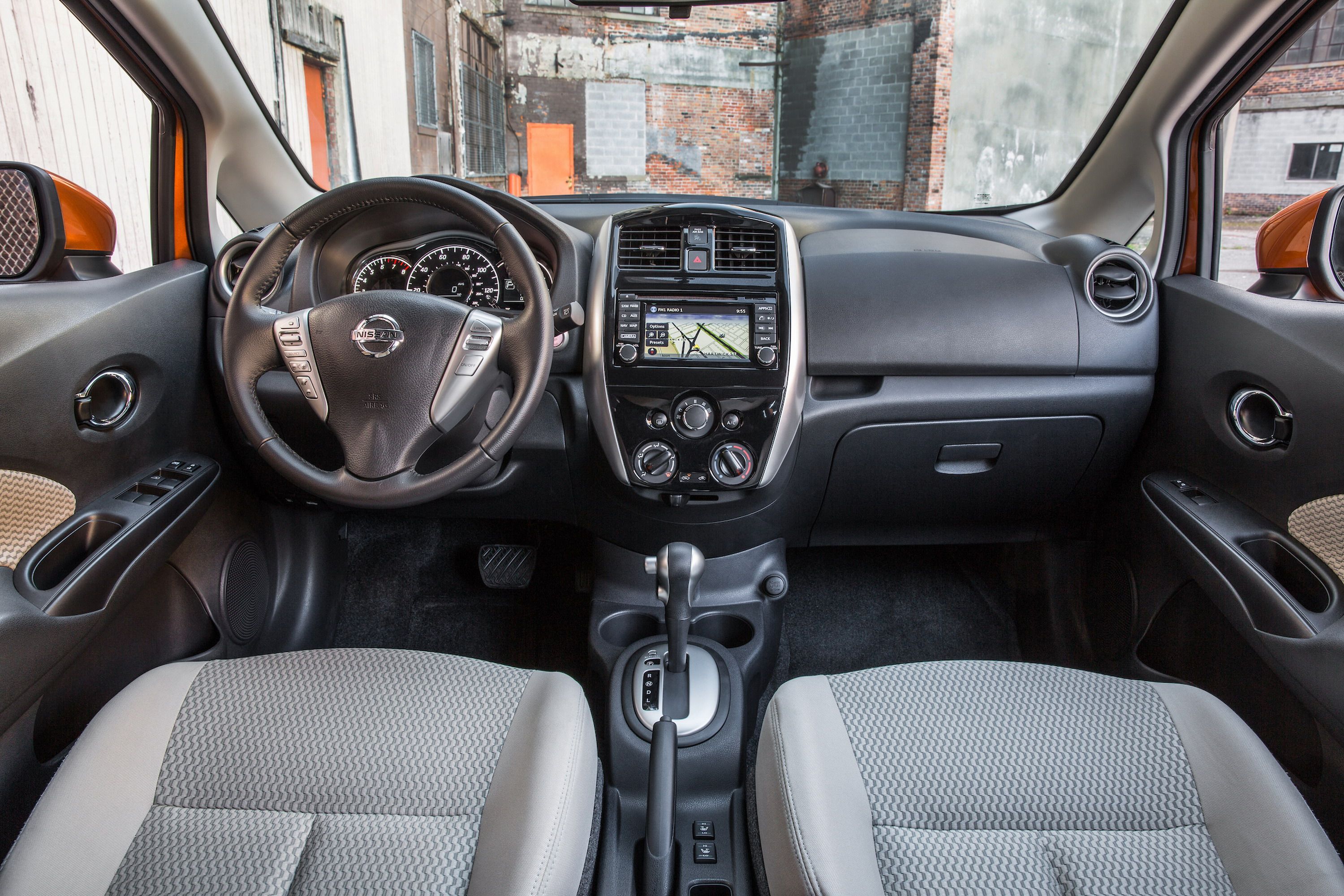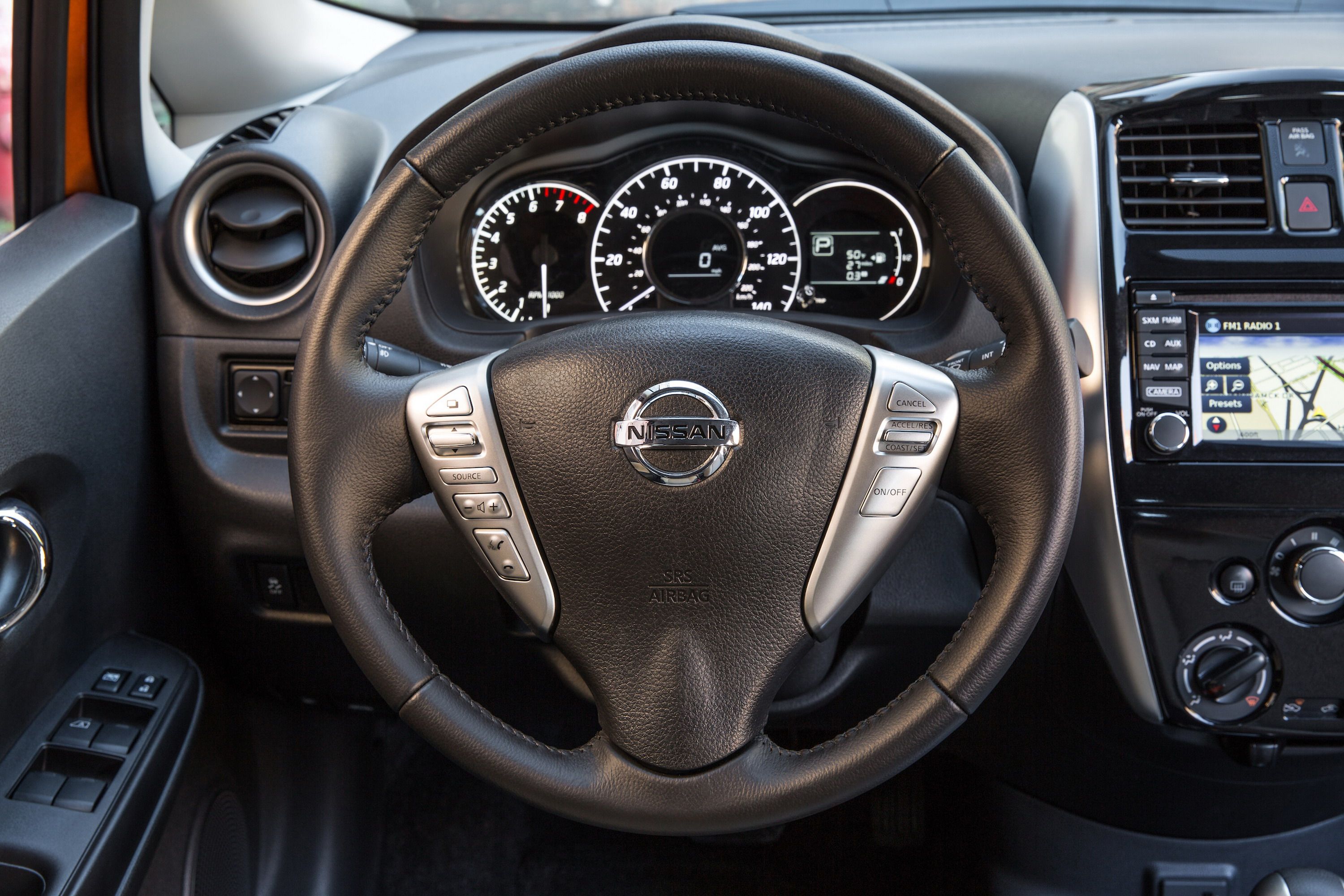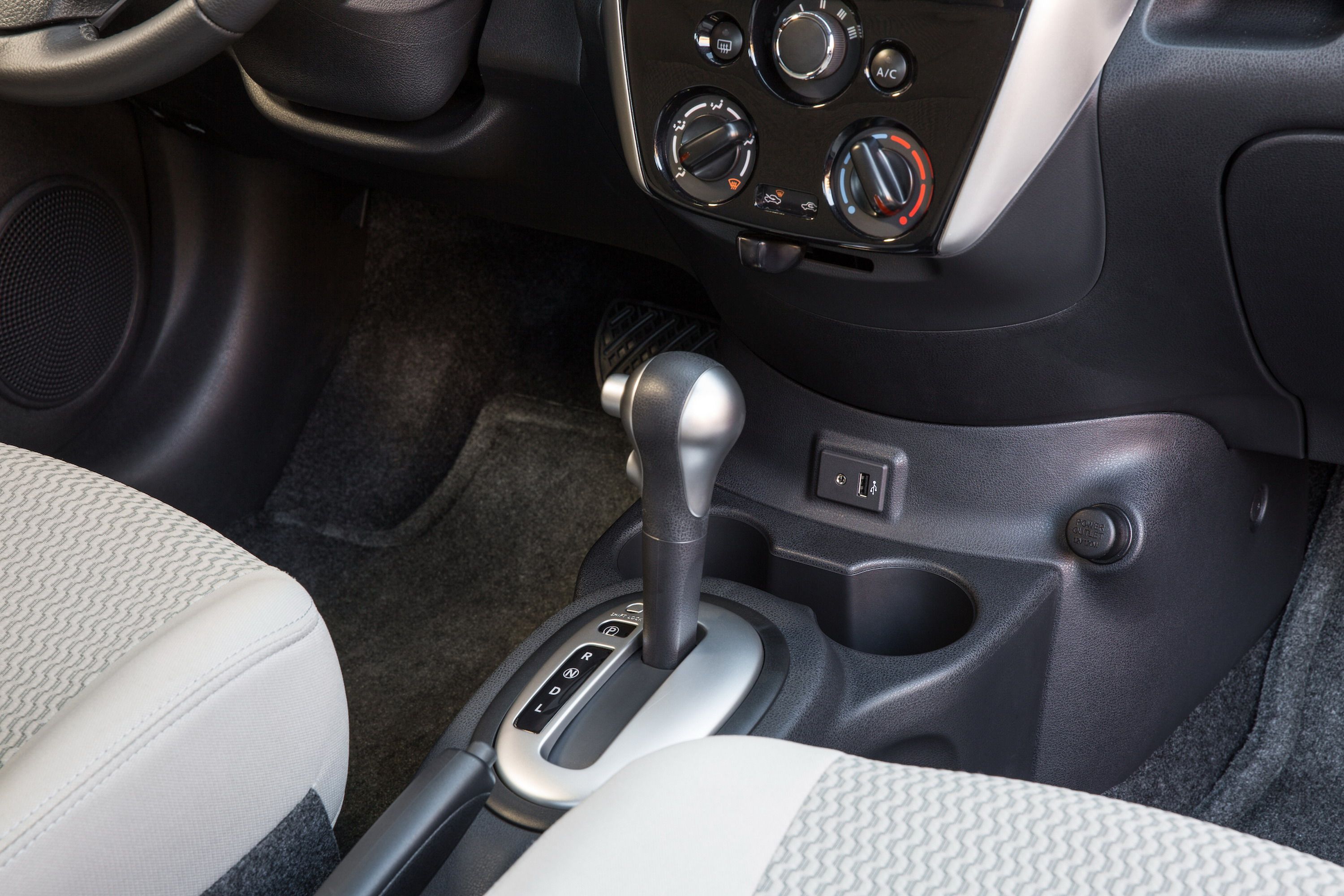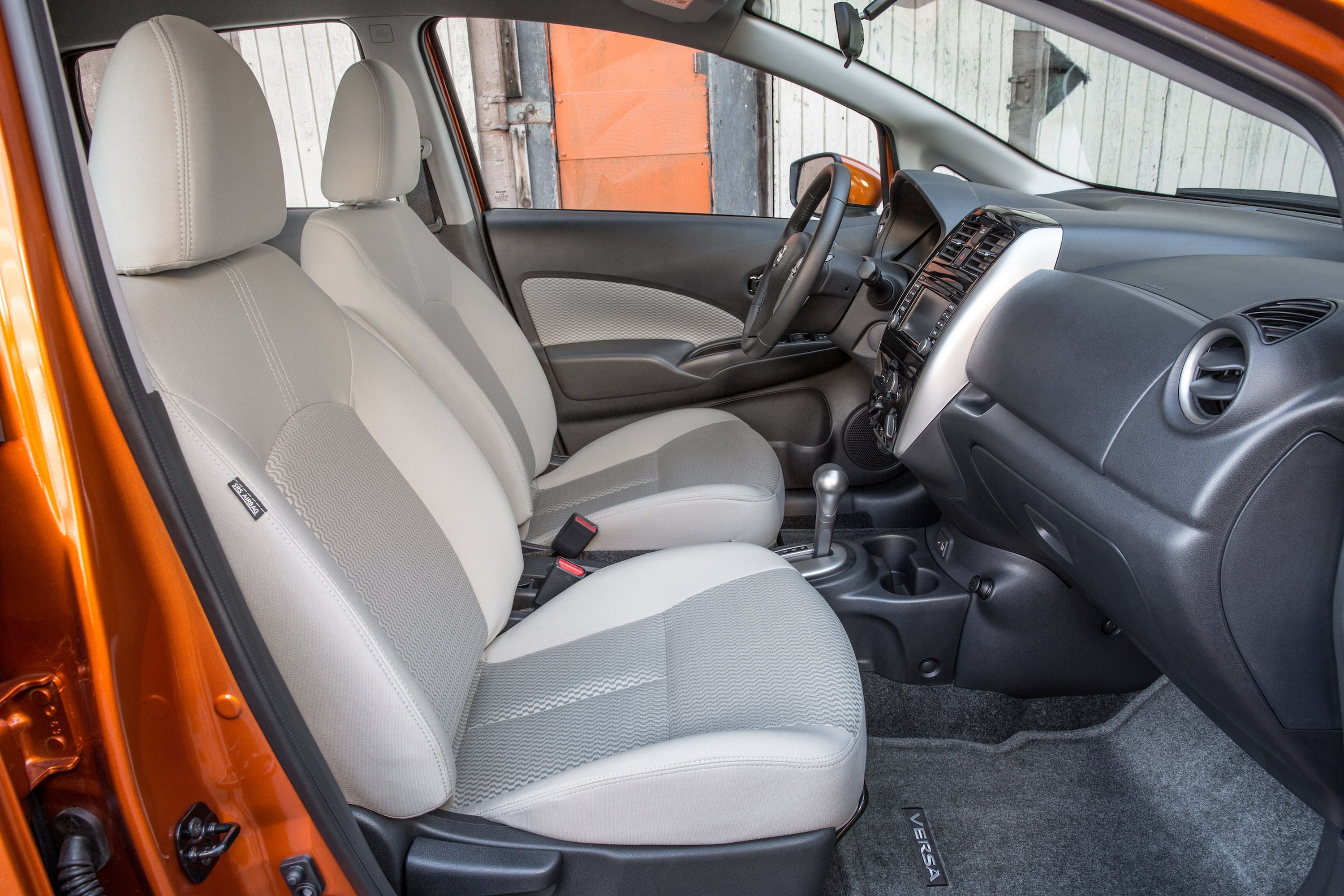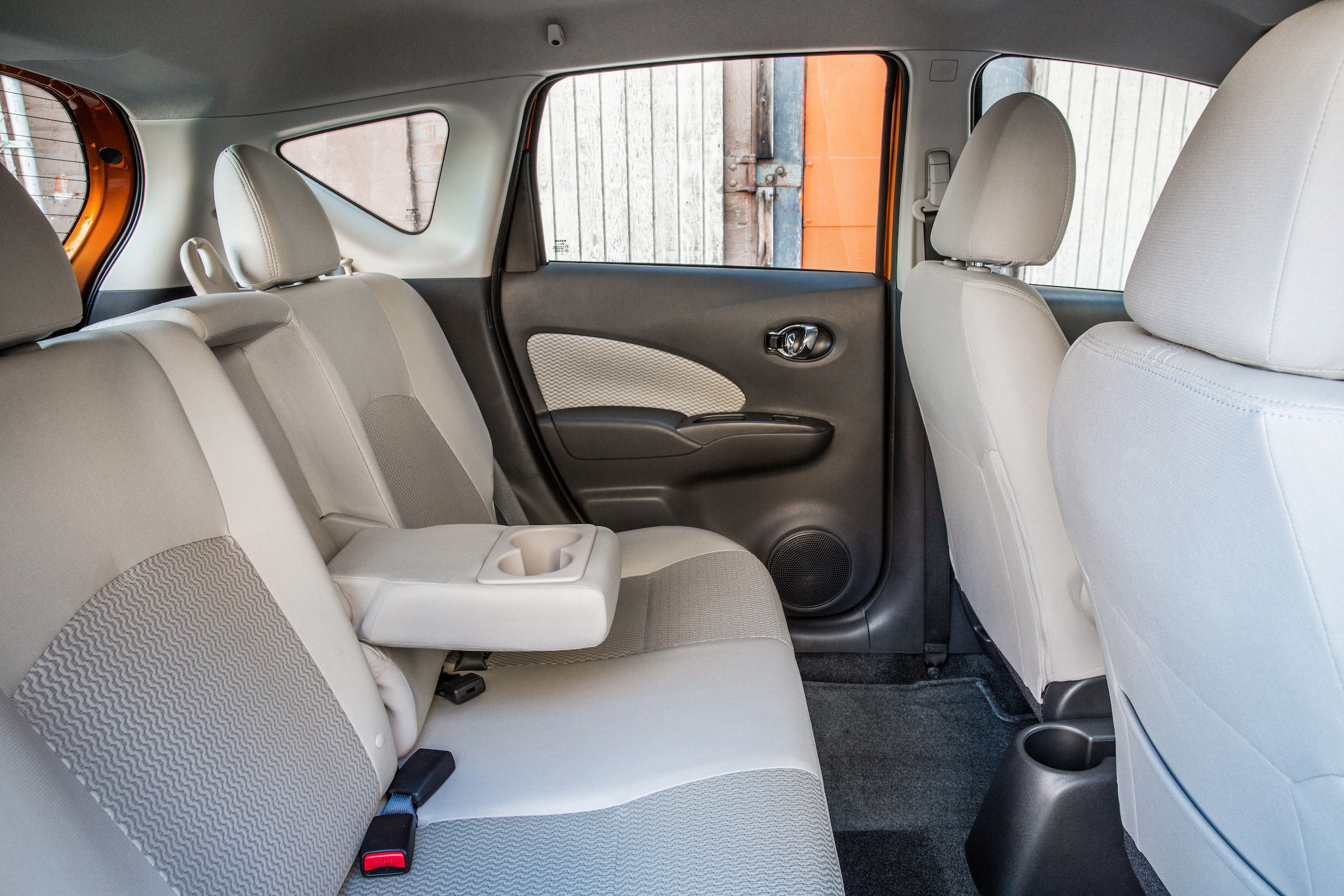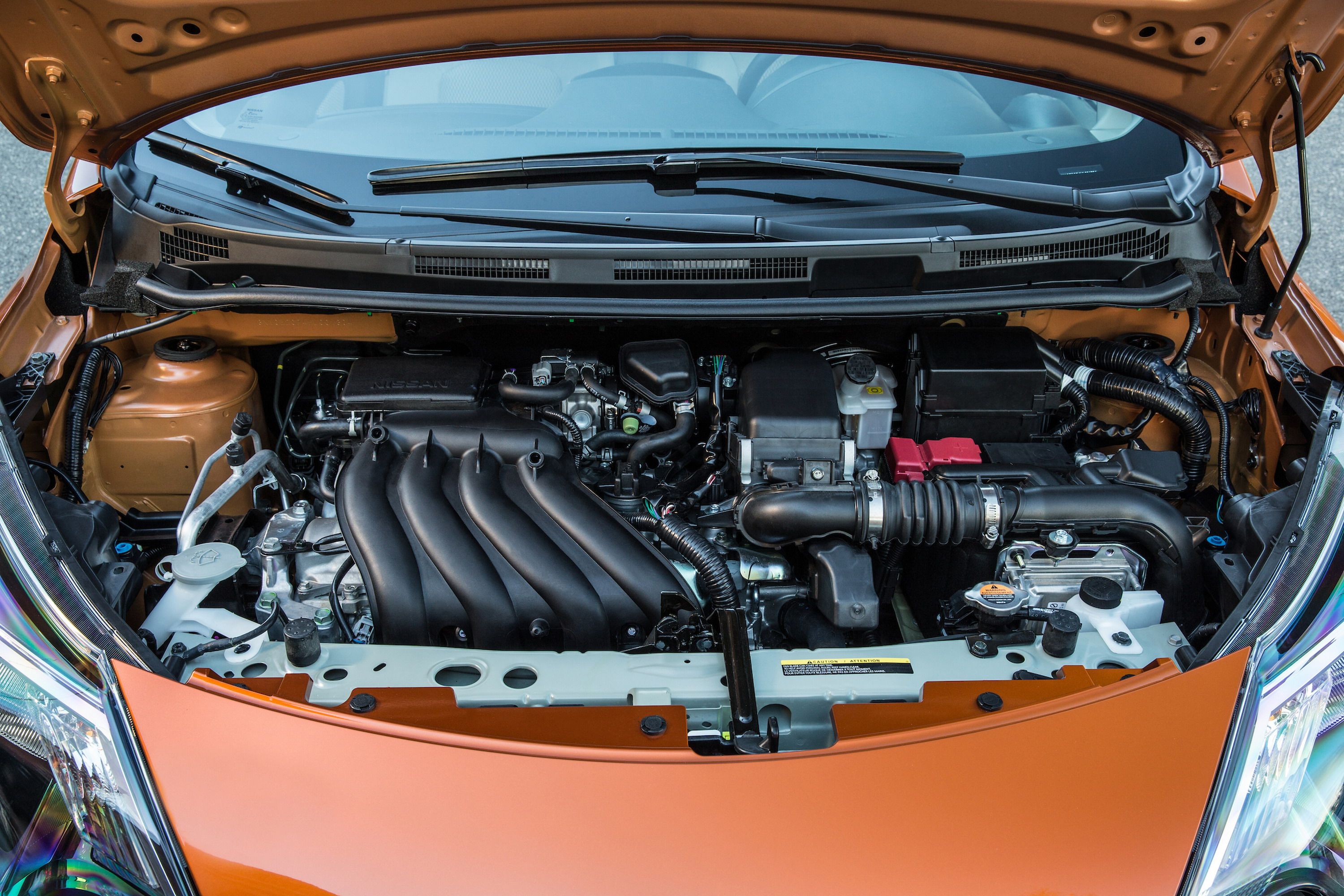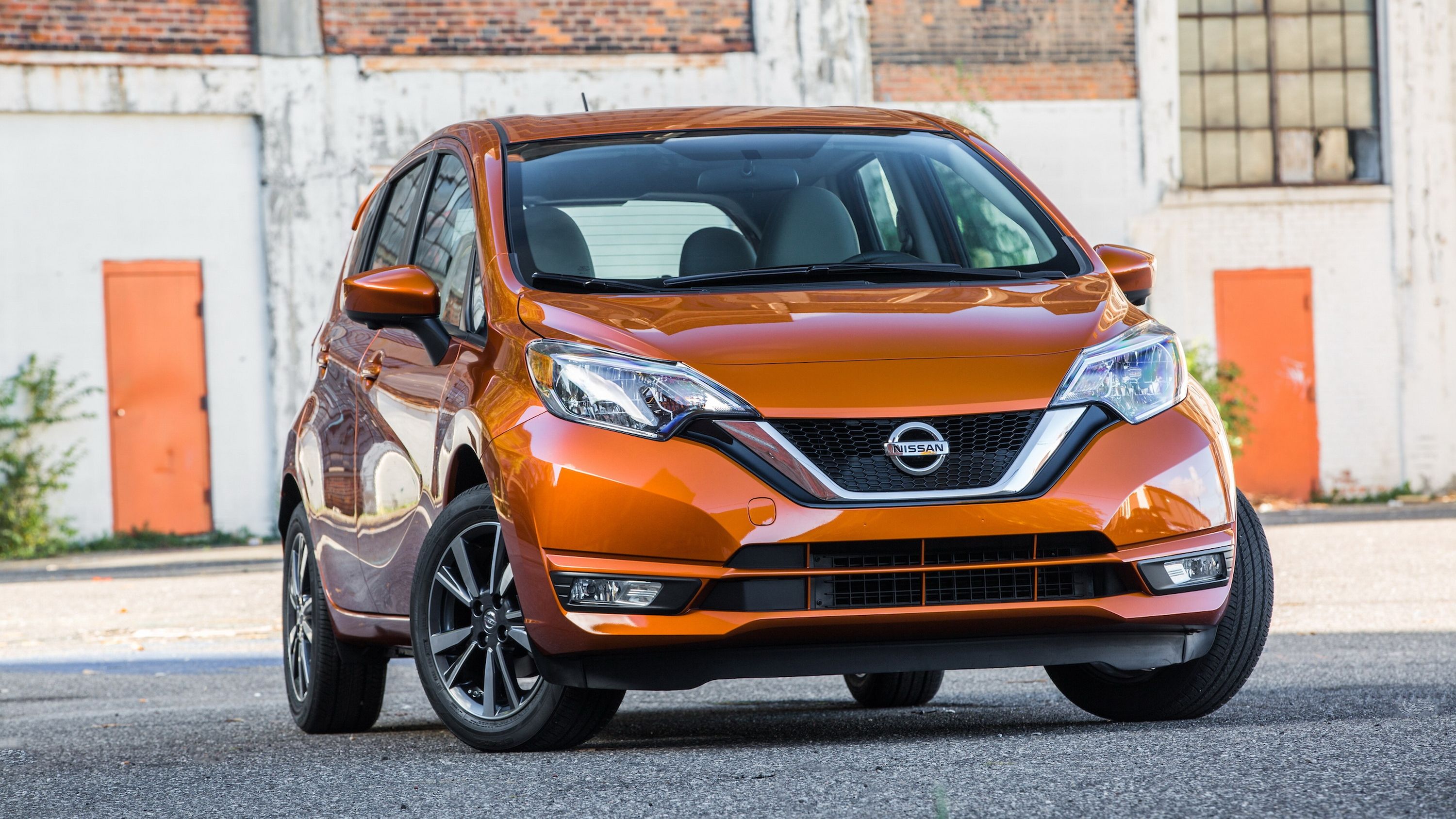Launched at the 2012 Geneva Motor Show, the second-generation Note arrived on a new platform that Nissan introduced with the Micra. Although slightly longer and wider than its predecessor, the new Note had a significantly lower roof, trading the former MPV-style looks for a more standard hatchback layout. The Note crossed the pond to the U.S. in 2013, when it replaced the hatchback version of the Versa and was renamed the Versa Note. The North American model also sports the biggest engine available with the nameplate globally, a 1.6-liter four-cylinder. In other markets, the Note uses a 1.2-liter three-cylinder and a 1.5-liter four-pot diesel. The Versa Note was redesigned for the 2017 model year, when it received Nissan's recent styling language and a few interior updates.
Much like all recent redesigns and facelifts, the updated Versa Note adopted Nissan's "V-Motion" grille, a design highlight that is already available on the majority of the company's vehicles. In the U.S., the Verso and the Verso Note were the last models to not feature the grille. Thanks to the new "V-Motion" element, the Versa Note bears a closer family resemblance to the larger Nissan Sentra, Altima, and Maxima, while also boasting a sportier design that's more in line with recently updated competitors such as the Honda Fit, Chevrolet Sonic, and Ford Fiesta.
"Versa Note and Versa sedan combine to be America’s best-selling nameplate in the entry level segment," said Michael Bunce, vice president of product planning. "The enhancements for the new model year give Versa Note a fresh new look, which should help keep the Versa pair in the number one position again in 2017."
It remains to be seen whether Bunce's comment proves to be accurate with so many cars fighting for supremacy in this segment, but until those sales figures come rollin' in, let's have a closer look at what the facelifted Versa Note brings to the table.
Continue reading to learn more about the 2017 Nissan Versa Note.
2017 Nissan Versa Note
- Make: Array
- Model: 2017 Nissan Versa Note
- Segment: Array
- [do not use] Vehicle Model: Array
|
|
center> Exterior |
Arguably the biggest change with this facelift is the redesigned front fascia that now incorporates Nissan's trademark "V-Motion" grille. Narrower than the previous grille, but taller, the new element flows seamlessly with the swept-back halogen headlight, which have also been altered. Down below, the Versa Note received a sportier bumper with a two-tier central intake and rectangular foglamps instead of the old round ones. The foglamps also feature black bezels, giving the car a more upscale look.
Around back, the Versa Note carries over unchanged, but Nissan now offers the sporty rear fascia upgrades of the SR trim on the S Plus, SV, and SL grades. This means that all but the base model comes with the sporty bumper with black-painted, diffuser-like element and the tailgate spoiler. The S Plus and SV trims also get new wheel covers, while the range-topping SL grade boasts a revised 16-inch aluminum-alloy wheel design. Customers who go with the sporty Note SR will also benefit from body-colored side sills and side mirrors with integrated turn signals.
Finally, the Versa Note gets two new exterior colors: Monarch Orange and Deep Blue Pearl. The new finishes add to the existing color palette that includes Brilliant Silver, Metallic Peacock, Super Black, Cayenne Red, Gun Metallic, Aspen White, and Metallic Blue.
COMPETING DESIGNS
This segment is literally packed with options, so I picked three of the most popular choices to compare the Versa Note against. First up, we have the Honda Fit (left). Known as the Jazz in other markets, the Fit was redesigned for the 2014 model and up until now it was one of the better looking hatchbacks in this class. Its styling feels modern thanks to Honda's new corporate design, while the rear end's Civic-inspired elements give it a sporty stance. However, now that the Versa Note gained a "V-Motion" grille, picking the Fit over the Nissan is no longer easy.
The same goes for the Chevrolet Sonic (right). Before its 2017-model-year update, the small Chevy wasn't exactly pleasing to look at, but the redesign moved it on the more appealing side of the compact market. Now featuring styling cues seen on larger cars, including the Malibu, the Sonic is a solid option if you're looking for a hatchback that's almost as good looking as a bigger Chevy. The third car on our list is the Ford Fiesta (center). Although it's the old car in the group, having been launched in 2008, the current Fiesta is still fresh thanks to its 2013 redesign and it has already established itself as a popular choice on the subcompact market. Now sporting the familiar trapezoidal grille and large, swept-back headlamps, the Fiesta has what it takes to give its recently refreshed competitors a run for their money.
Competing Exterior Dimensions
|
Nissan Versa Note |
Honda Fit |
Chevrolet Sonic |
Ford Fiesta |
|
|
Wheelbase (Inches) |
102.4 |
99.6 |
99.4 |
98 |
|
Overall length (Inches) |
163.0 |
160.0 |
159.0 |
159.7 |
|
Overall width (Inches) |
66.7 |
60.0 |
59.7 |
67.8 |
|
Overall height (Inches) |
60.5 |
67.0 |
68.3 |
58.1 |
Interior
Much like any mid-cycle facelift, the Versa Note carries over with the original interior layout. Modifications are rather mild and include larger cup holders and the relocation of the 12-volt outlet and USB auxiliary port to the front of the center console. Nissan also offers a few extra goodies on the more expensive trims, starting with a Juke-style leather steering wheel and suede-like seats for the SR model. The Note SL gets NissanConnectSM with Navigation and Mobile Apps, a 5.8-inch color touch-screen display, Voice Recognition for navigation and audio, SiriusXM Traffic, Around View Monitor2, heated front seats. The automaker says that all these tweaks were made based on customer feedback. It's nice to know that Nissan pays attention to the drivers' need.
Everything else remains unaltered, but that's by no means a negative for the hatchback. When we drove the Versa Note back in 2014, we found that the cabin felt like it was created to make it feel as large as possible, with legroom significantly better than competitors from Ford and Chevy. Headroom is also excellent thanks to the high and slightly arched roofline. Roominess aside, the Versa Note is also equipped with cool technology for this segment, including the exact same stereo head unit with crisp display and navigation as the Altima, the Google Send-To-Car and POI functionality, and the Around View monitor system originally pioneered for Infiniti products. One major downside is that the plastic on the dashboard, door panels, and center console feels rather cheap, but very few cars in this class can actually brag about a more upscale cabin.
COMPETING INTERIORS
By comparison, the Fit (left) offers the same amount of space front and rear, but the Honda comes with the more modern looking center stack, a larger, seven-inch display, and more contrasting trim on the dashboard and center console. The instrument cluster also feels sportier thaks to the stand-alone center gauge. The "Magic Seat" option enables you to pull the rear bottoms upward for more cargo room. On the flipside, navigation is optional for the range-topping model only.
Moving over to the Sonic (right), the Chevy has a revised interior that keeps the multi-layered dashboard and narrow center stack, but comes with a new instrument cluster with a refined speedometer and a new steering wheel. This model also boasts a seven-inch touchscreen that is larger than the Versa Note's and goodies such as 4G LTE with Wi-Fi hotspot, Apple Carplay, and Android Auto. The latter is a segment-exclusive feature, as is the power driver's seat. Options include keyless entry and start and heated seats, while the RS trim gets piano black trim and a flat-bottom steering wheel.
Last but not least, we have the Fiesta (center) and the improvements it gained for the 2014 model year. Although it's not the roomiest hatchback in its class, the Fiesta has a pretty interior that can be ordered in a two-tone paint scheme and a comprehensive technology package. The MyFord Touch comes with a 6.5-inch touchscreen, which is smaller than the Sonic and Fit, but larger than the Versa Note, while even the lowliest trims are equipped with SYNC Applink, which allows voice control for USB connected iPhones or Android devices.
Competing Interior Dimensions
|
Nissan Versa Note |
Honda Fit |
Chevrolet Sonic |
Ford Fiesta |
|
|
Head room - front (Inches) |
40.8 |
38.7 |
39.5 |
39.1 |
|
Leg room - front (Inches) |
41.3 |
41.8 |
41.4 |
31.2 |
|
Hip room - front (Inches) |
48.5 |
51.4 |
51.5 |
50.5 |
|
Shoulder room - front (Inches) |
51.7 |
53.4 |
54.8 |
52.7 |
|
Head room - rear (Inches) |
38.0 |
38.1 |
37.5 |
37.1 |
|
Leg room - rear (Inches) |
38.3 |
34.6 |
39.3 |
31.2 |
|
Hip room - rear (Inches) |
48.8 |
51.6 |
45.1 |
49.2 |
|
Shoulder room - rear (Inches) |
51.9 |
53 |
52.6 |
49 |
Drivetrain
The current-generation Versa Note arrived with just one engine, and that didn't change with the facelift. Specifically, the upgraded hatchback comes with the same 1.6-liter four-cylinder under the hood and output remains unaltered at 109 horsepower and 107 pound-feet of torque. The powerplant uses a dual injector system, continuously variable valve timing control, and electronic drive-by-wire, and even though it won't impress you from 0 to 60 mph, it delivers excellent fuel economy. According to the EPA, the Versa Note is good for up to 39 mpg highway and 31 mpg city with the Xtronic automatic with retuned D-Step Logic Control and up to 36 mpg on the highway and 27 mpg in the city with the five-speed manual transmission.
Like its predecessor, the updated hatchback comes with vented front discs and rear drum brakes, ABS at all four corners, electronic brake force distribution, brake assist, an independent strut front suspension with stabilizer bar, and a torsion beam rear agle with integrated stabilizer bar.
COMPETING PERFORMANCE
The Honda Fit also comes with just one engine, but its 1.5-liter four-cylinder offers significantly more oomph at 130 horsepower and 114 pound-feet. The manual transmission has one extra cog, making it a six-speed, while the second option is a CVT with Sport Mode. The suspension layout is very similar with a MacPherson strut front unit and a rear torsion-beam, as are the breaks with ventilated front discs and rear drums. Fuel economy is also competitive. The six-speed manual Fit returns up to 36 mpg on the highway and 29 mpg in the city, while CVT-equipped models can return up to 40 mpg highway and 33 mpg city depending on trim and specs.
Unlike the Versa Note and Fit, the Sonic is available with a choice of two engines. Both crank out 138 horsepower, but while the naturally aspirated 1.8-liter generates 125 pound-feet of torque, the 1.4-liter turbo is good for 148 pound-feet. The former mates to either a five-speed manual or a six-speed automatic, while the latter can be paired with either a six-speed manual or a six-speed automatic. The 1.8-liter returns 35 mpg highway with 26 mpg city, while the 1.4-liter is good for 40 mpg on the highway and 29 mpg in the city. All told, the Sonic is marginally less efficient than its rivals, but has the more powerful engine.
Finally, the Ford Fiesta is also sold with two engines, a naturally aspirated and a turbo unit. The all-motor is a 1.6-liter four-cylinder rated at 120 horsepower and 112 pound-feet, while the turbo is a 1.0-liter three-pot with 123 horses and 148 pound-feet. The former can be had with either a five-speed manual or six-speed automatic, while the latter with stuck with the manual only. As far as fuel economy goes, the 1.6-liter with the manual transmission returns 35 mpg on the highway and 27 mpg in the city, while the optional automatic increases the highway figure to 36 mpg. The 1.0-liter EcoBoost on the other hand is good for an impressive 41 mpg on the highway and 35 mpg in the city, arguably the best figures in this comparison.
Competing Drivetrain Specifications
|
Nissan Versa Note |
Honda Fit |
Chevrolet Sonic |
Chevrolet Sonic |
Ford Fiesta |
|
|
Engine |
1,598 cc 4-cylinder |
1,498 4-cylinder |
1.8L DOHC I-4 |
1.4L turbocharged DOHC I-4 |
1.6L 16-valve Ti-VCT I-4 |
|
Horsepower |
109 HP @ 6,000 RPM |
130 HP @ 6,600 RPM |
138 HP @ 6,300 RPM |
138 HP @ 4,900 RPM |
120 HP @ 6,350 RPM |
|
Torque |
107 LB-FT @ 4,400 RPM |
114 Lb-FT @ 4,600 RPM |
125 LB-FT @ 3,800 RPM |
148 LB-FT @ 2,500 RPM |
112 LB-FT @ 5,000 RPM |
|
Transmission |
Xtronic automatic |
6-Speed Manual |
6-Speed manual |
6-Speed manual |
5-speed manual |
|
EPA city/highway/combined |
31/39/34 |
29/36/32 |
26/35 |
29/40 |
28/36/31 |
Prices
|
|
ids=154228,694836 |
no_overlay=true> |
Pricing for the updated Versa Note starts from $15,480. That's $1,250 more than last year's sticker, but there's a catch. While the 2016 model year included an S base model, Nissan deleted the entry-level trim for 2017, making S Plus as the least expensive model. And at $15,480, prices are identical. Go for the better equipped SV model with keyless entry, five-inch display, Rear Vew Monitor, power windows, and leather-wrapped steering wheel and the sticker jumps to $16,380. Next up is the SR at $17,980, but for the extra cash you get 16-inch wheels, side mirrors with LED turn signals, suede seats, and many more. Finally, the range-topping SL model, which comes with Nissan Connect with Navigation and Mobile apps, SiriusXM Traffic, and heated side mirrors, retails from $18,710.
COMPETING PRICES
The Honda Fit is a bit more expensive than the Versa Note, starting from $15,990 with the six-speed manual transmission and $16,7090 with the CVT. The Chevy Sonic, on the other hand, retails from $18,455, which makes it almost $3,000 more expensive than the Nissan. For this amount you get the LT trim, which is a step up from the base LS, available only with the sedan. Upgrading to the Premier model will increase the sticker to $20,595, while the Premier with the automatic transmission and turbo engine costs $22,090 before options. The Ford Fiesta is the only car in this comparison that's actually more affordable than the Versa Note. The entry-level S model starts from $14,390, while the SE, which is the one to compare to the Versa Note S Plus, comes in at $15,620. The top-of-the-line Titanium model goes for $18,340 before options.
|
Versa Note 1.6 S Plus Xtronic |
$15,480 USD |
|
Versa Note 1.6 SV Xtronic |
$16,380 USD |
|
Versa Note 1.6 SR Xtronic |
$17,980 USD |
|
Versa Note 1.6 SL Xtronic |
$18,710 USD |
Competing Prices
|
Ford Fiesta S |
$12,265 |
|
Ford Fiesta SE |
$15,915 |
|
Ford Fiesta Titanium |
$16,216 |
|
Honda Fit LX |
$15,990 |
|
Honda Fit EX |
$17,900 |
|
Honda Fit EX-L |
$20,265 |
|
Honda Fit EX-L with Navi |
$22,165 |
|
Chevrolet Sonic LS |
$16,020 |
|
Chevrolet Sonic LT |
$18,045 |
|
Chevrolet Premier |
$20,595 |
What Others Are Saying
The Versa Note has received largely positive reviews since its redesign, but there are a few important outlets that have criticized the Japanese hatchback.
For instance, Edmunds rated the car with 4.5 stars out of five, praising it for its roomy interior, large cargo capacity, high fuel economy with the CVT gearbox, and low base price. On the "cons" side, Edmunds listed "bland performance and handling; noisy engine; no telescoping steering wheel; low-quality interior materials."
Kelley Blue Book also posted a positive review of the car, rating it 8.9 out of ten. The publication says you'll like it if "finding economical transportation at a fair price is more important than finding a ride that will get your heart racing, Nissan’s 2016 Versa Note hatchback will likely strike a chord. It’s frugal at the pump and easy to drive, yet can easily accommodate four adults." On the flipside, you may not like it if "you’re the slightest bit a driver at heart, cars like the Honda Fit, Ford Fiesta and Chevy Sonic are so much more fun to toss around the curves. The Versa Note for 2016 isn’t big on power, either, and the base model’s crank windows may be a deal killer."
The Versa Note received most criticism from Car and Driver, which rated it only 1.5 stars out of five. The outlet's main gripes with the car are the "weak 1.6-liter four-cylinder" and either "sloppy five-speed manual or drone-inducing CVT," and bland road behavior. The website praises it for the "handsome styling, roomy back seat," and good fuel economy, but recommends you pick "a competitor or even a used car before dropping your cash on one of these." That's pretty harsh.
Competition
We've already discussed three of the Versa Note's most important competitors, but let's have a look at other options available in the U.S.
Toyota Yaris
Yet another popular subcompact in both North America and Europe, the Toyota Yaris was redesigned for the 2015 model year, getting a strangely handsome exterior that feels more youthful and sports more of the company's corporate design language. While sporty on the outside, the Yaris feels a bit mundane on inside, where a simple dashboard and loads of plastic sum up the cabin. Rear seat and luggage room are decent, but there isn't much tech to talk about in the base model, with power windows and power adjustable mirrors being the only electronically operated creature comforts. The radio does come with steering wheel-mounted controls and cruise control is present. Pricing starts from $16,000, but increases to $17,285 and 18,000 as you navigate through the LE and SE trims.
Find out more about the Toyota Yaris here.
Kia Rio
Kia redesigned the Rio for the 2017 model year in Europe, but the hatchback has yet to cross the pond to the U.S., where the Korean automaker is still offering the old model. However, when the new car will replace the dated model, the Versa Note will get a fresh and good looking rival that borrows most of its styling cues from larger Kia models. A massive step forward design-wise, the Rio is no longer the ugly duckling of the subcompact class and it's quite sporty to look at thanks to the horizontal features that accentuate its width. Inside, the new Rio is arguably the better looking vehicle in this comparison with a modern dashboard, softer plastic surfaces, and upgraded tech. The Rio comes with both Android Auto and Apple CarPlay integration and is the first vehicle in its class to offer Autonomous Emergency Braking with pedestrian recognition. You didn't expect that from a Kia, didn't you? Pricing is obviously a mystery, but with the outgoing model priced from $15,495, the next-generation Rio should retails from around $16,500.
Learn more about the Kia Rio here.
Conclusion
The Versa Note might not be the most powerful vehicle in its class and its interior might lack the niceties and newer tech offered by its competitors, but it's a pretty fair package for the buck. The fact that Nissan eliminated the base trim might push customers on a tight budget toward the Ford Fiesta, but this could also help with the nameplate's marketing now that the entry-level car has more equipment than ever. Although most of its competitors have slightly better tech, larger touchscreen, and fancier options in range-topping model, the Versa Note will remain competitive for a while thanks to this facelift. However, the sporty looks that come with the "V-Motion" grille won't be enough to keep sales up for more than a year or so, especially with the new Rio on its way to the U.S. Prices will most likely drop as Nissan begins testing the next-generation hatchback. If you're patient enough, you might score a good deal on this car.


